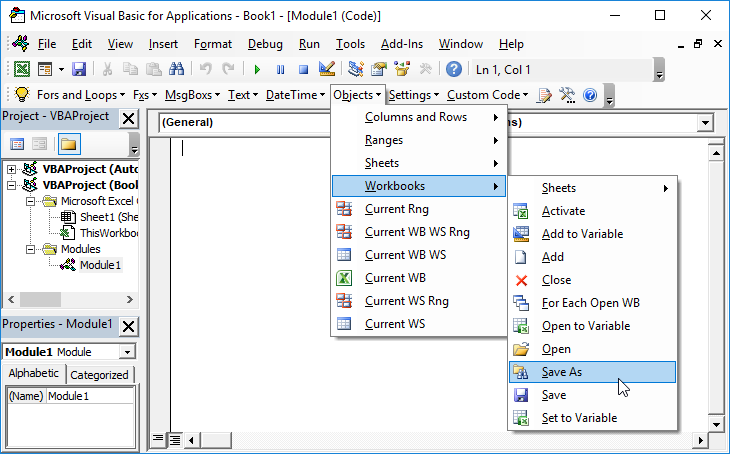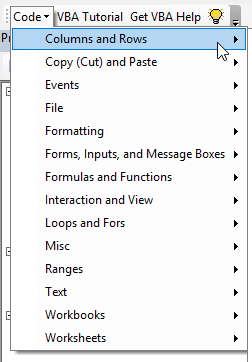
The VBA Save command saves an Excel file similarly to clicking the Save icon or using the Save Shortcut (CTRL + S).
To save a workbook, reference the workbook object and use the Save command.
Workbooks("savefile.xlsm").SaveNote: This is the current active workbook from with in the VBA code, which is different from ThisWorkbook which contains the running code.
ActiveWorkbook.SaveStop searching for VBA code online. Learn more about AutoMacro – A VBA Code Builder that allows beginners to code procedures from scratch with minimal coding knowledge and with many time-saving features for all users!

ThisWorkbook.saveThis will loop through all open workbooks, saving each one.
Dim wb as workbook For Each wb In Application.Workbooks wb.Save Next wbNote: opening a workbook in ReadOnly mode prevents the file from being saved.
To save the file you will need to use Save As and save the file with a different name.
Dim wb as workbook For Each wb In Application.Workbooks If not wb.ReadOnly then wb.Save End if Next wbThis will save a workbook that was assigned to a workbook object variable.
Dim wb as workbook set wb = workbooks("savefile.xlsm") wb.saveThis will save a workbook that’s name was saved to a string variable.
Dim wbstring as string wbstring = "savefile.xlsm" workbooks(wbstring).saveNote: The first workbook opened would have 1, the second 2, etc.
workbooks(1).saveThis will save a workbook that’s name is found in a cell value.
Dim wbstring as string wbstring = activeworkbook.sheets("sheet1").range("wb_save").value workbooks(wbstring).saveThe VBA Save As command saves an Excel file as a new file, similar to clicking the Save As icon or using the Save As Shortcut (Alt > F > A).
Above, we identified all the ways to specify which workbook to save. You can use those exact same methods to identify workbooks when using Save As.
Save As behaves similarly to Save, except you also need to specify the name of the new file.
In fact, Save As has many potential variables to define:
workbook object .SaveAs(FileName, FileFormat, Password, WriteResPassword, _ ReadOnlyRecommended, CreateBackup, AccessMode, ConflictResolution, _ AddToMru,TextCodepage, TextVisualLayout, Local)A full description of all of the SaveAs arguments is included below. For now we will focus on the most common examples.
Note: These arguments can be entered as string with parenthesis or as defined variables.
ActiveWorkbook.SaveAs Filename:= "new"ActiveWorkbook.SaveAs "new"Dim wbstring as string wbstring = "new" ActiveWorkbook.SaveAs Filename:= wbstringActiveWorkbook.SaveAs Filename:= "C:\new"Dim wbstring as string wbstring = "C:\new" ActiveWorkbook.SaveAs Filename:= wbstringActiveWorkbook.SaveAs Filename:= "C:\new.xlsx"Dim wbstring as string wbstring = "C:\new.xlsx" ActiveWorkbook.SaveAs Filename:= wbstringYou can also specify the file format in it’s own argument.
.xlsx = 51 '(52 for Mac) .xlsm = 52 '(53 for Mac) .xlsb = 50 '(51 for Mac) .xls = 56 '(57 for Mac)ActiveWorkbook.SaveAs Filename:= "C:\new", FileFormat:= 51ActiveWorkbook.SaveAs Filename:= "C:\new.xlsx", Password:= "password"If correct password is not supplied then workbook opens as Read-Only
ActiveWorkbook.SaveAs Filename:= "C:\new.xlsx", WriteRes:= "password"TRUE to display a message box, recommending that the file is opened read-only.
ActiveWorkbook.SaveAs Filename:= "C:\new.xlsx", ReadOnlyRecommended:= TRUEThis Generates the Save As Dialog Box, prompting the user to Save the file.
Keep in mind that this simple code may not be appropriate in all cases.
Application.GetSaveAsFilenameApplication.GetSaveAsFilename InitialFilename:="test.xlsx"Application.GetSaveAsFilename InitialFilename:="test.xlsx"This will create a new workbook and immediately save it.
Dim wb As Workbook Set wb = Workbooks.Add Application.DisplayAlerts = False wb.SaveAs Filename:=”c:\Test1.xlsx” Application.DisplayAlerts = True As you work with saving in VBA, you may come across various Save Warnings or Prompts. To disable warnings, add this line of code:
Application.DisplayAlerts=Falseand to re-able alerts:
Application.DisplayAlerts=True
Easily access all of the code examples found on our site.
Simply navigate to the menu, click, and the code will be inserted directly into your module. .xlam add-in.
(No installation required!)